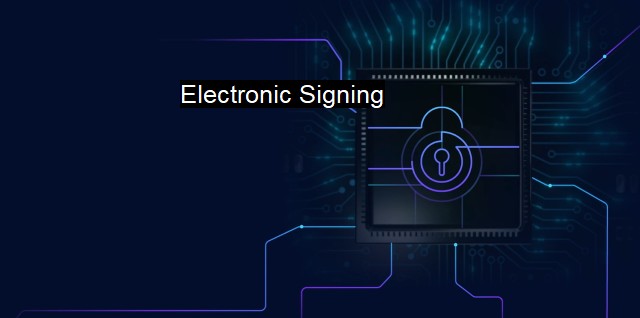What is Electronic Signing?
The Relevance of Electronic Signing in Cybersecurity and Antivirus: Secure and Tamper-Resistant Digital Solutions for Authentic Legal Trade and Regulatory Compliance
Electronic signing, often referred to as an e-signature, is a broad term referring to any electronic procedure that signifies an approval of content found in digital documents or forms. Its foundational purpose is to replace physical 'pen on paper' signatures, providing a more convenient, streamlined process for authenticating documents in the digital realm.In the present technological age, we increasingly rely on myriad industries' digital procedures; the cybersecurity context pertinent to electronic signing thus becomes superficially apparent. Gathering data essential to organisations' operations, handling documents without involving unnecessary entities, and the efficient transfer and storage of information, all whilst ensuring granted access is legal and ethical, has become integral in modern society, asserting the increasing importance of cybersecurity accompanying technological advancements.
Primarily, the utilization of electronic signing assures the guarantee of data integrity. Algorithms seal data with an electronic signature upon the release. Consequently, if a third party modifies the data upon dispatch, authorities can promptly identify this development, as the data integrity is compromised. Thus, this technology ensures the delivery of accurate information, without compromise.
One major vulnerability of electronic data transfer in cyberspace is the threat of hacking. E-signatures furnish additional security layers that instigate novel and dynamic consent avenues. For instance, hackers could easily access email threads and manipulate unsecured strings. Through encrypted electronic signatures, hackers are deterred from unauthorized incapacitation, misappropriation, or exploitation of fundamental data - an essential cybersecurity objective. Hence, this cybersecurity measures ensures critical stakeholders' negotiations and unanimous agreements evade the risk of manipulation or forgery.
An electronic signature also authenticates a user's identity effectively. Using digital certificates in authentication procedures, issuers can validate a corporation, gateway, firewall, or person's identity. Accompanying electronic signatures, public and private keys are applied to initiate encryption and decryption procedures. Public keys are outwardly friendly and can demonstrate a stakeholder's key authenticity or a signed contracted transaction connected to acting parties.
'non-repudiation' refers to the complexity in denying authenticity once such electronic data bars retraction upon infringement. Using electronic signatures for transactions Istanbul compulsory for parties involved to lever-proof non-repudiation once a contract is digitally signed. This mechanism simultaneously disseminates data security, as signed files are impossible to forge. Therefore, in terms of cybersecurity, electronic signatures offer robust authentication facilities without compromising the ease of use.
In the context of antivirus programs, e-signatures similarly play a compelling role. Regular system scans compare cryptographic hashes in files against large databases collectively carrying scores of hashes, dubbed as antivirus signatures. Upon identifying malicious files represented by unique hashes, the antivirus alerts the users followed by the option to isolate or reduce these fileborne threats. Automated immediate updates from global security enterprises allow immediate action against potentially devastating invasions.
Deploying electronic signatures on virus definitions allows immediate identification of associated threats utilizing key antivirus capabilities. Several antivirus programs, for instance, support electronic signature-based detection allowing an immediate evaluation against protected viruses, worms, adware, malware, or other threats. Viruses can seamlessly intrude, clone, and multiply, integrating into applications, files, or software. Encoded binary signatures attempt identifying the virus by fragment screening, leveraging binary string sequences attributed to each potential threat. Through electronic signatures, formula latent inspection of antivirus mechanisms improve vastly.
Electronic signing coupled with advanced cybersecurity measures possesses the futuristic capability of overcoming traditional complications concerning privacy and security. As the world teeters ever closer to higher rates of digitization across various sectors, the demand for seamless and secure methods penetrates every level of interaction. As we incorporate effective security-enhancing protocols often overlooked in haste, the combined synergy of antivirus applications, digital encryption, and a robust framework ensures electronic signings are a crucial instrument neglecting which might potentially jeopardize platforms in digital medium.

Electronic Signing FAQs
What is electronic signing?
Electronic signing refers to the process of signing digital documents using electronic means instead of traditional paper-based methods. The electronic signature can be applied to documents such as contracts, agreements, or other legal documents.Are electronic signatures secure?
When implemented properly with strong security measures, electronic signatures can be just as secure as traditional signatures. However, it is important to ensure that the electronic signature solution complies with regulatory requirements and uses encryption to protect the integrity of the signed document.How can antivirus software help with electronic signing?
Antivirus software can help protect electronic signatures by detecting and preventing malware or other threats from compromising the integrity of the signed document. A well-designed antivirus solution can help keep electronic signatures safe from cyber attacks and prevent unauthorized access to sensitive documents.What are the benefits of electronic signing over traditional paper-based signing?
Electronic signing offers several benefits over traditional paper-based signing, including faster turnaround time, increased efficiency, and reduced costs associated with printing, mailing, and storage of paper documents. Electronic signatures are also more environmentally friendly and can be signed from anywhere, at any time, by authorized parties with access to the document.| | A | | | B | | | C | | | D | | | E | | | F | | | G | | | H | | | I | | | J | | | K | | | L | | | M | |
| | N | | | O | | | P | | | Q | | | R | | | S | | | T | | | U | | | V | | | W | | | X | | | Y | | | Z | |
| | 1 | | | 2 | | | 3 | | | 4 | | | 7 | | | 8 | | |||||||